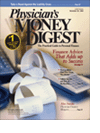Publication
Article
Physician's Money Digest
Finance Advice That Adds up to Success
Author(s):
Wall Street Journal
If you're a regular reader of the ,you probably have heard of Jonathan Clements,author of the financial column "Getting Going."In his 10th anniversary column on October 27, heshared some very useful insights.
Future Returns
Since 1925, the S&P 500 has provided an averageannual return of 10.4% with reinvested dividends.Clements points out that it is unlikely that the stock marketwill repeat this feat in the future. Most knowledgeablepeople think that future returns will be much lower.
A key reason Clements points out is that in 1925,the price per earnings ratio of the market was lowerand the dividend yield was much higher than today,which contributed greatly to the 10.4% annualreturn. For the future, an annual 6% return for thestock market and a 4.5% return for the bond marketmay be more realistic. For those who can stomach therisk, he recommends putting money into emergingmarket stock funds.
In one way or another, most investors pay investmentcosts of over 2% per year, and even if they canput most of their retirement savings in tax-deferredaccounts, it is likely that they will pay taxes of 25% onwithdrawals. Also, it is reasonable to assume that thelong-term inflation rate will be 3% per year or so. Oncethese are factored in, the real return an investor will beable to earn may be as low as 1% to 2% per year.
Most of us need to save a lot more. To avoid thetax drains, we need to closely watch all investmentcosts and try to keep them below 1% per year, contributethe maximum to all tax-deferred investmentswe can qualify for, and trade very little in taxableaccounts. But in your zeal to save taxes, don't fall fortax shelters or annuities. You may save some taxes,but you will probably pay a lot more in expenses andpoorer returns.
Need for Help
Clements writes, "Unfortunately, during the pastdecade, my confidence in the investment acumen ofordinary investors has been shaken. I have comeacross too many serial blunderers, folks who jumpedfrom technology stocks in the late 1990s to bonds inthe bear market to real estate investment trusts in2004, always buying after the big money has alreadybeen made."
Many of my colleagues and I once thought thatwith some time and effort, everyone could learn tobecome decent, even great investors. But just as ittakes years of education, training, and experience fora physician to write that 1-minute prescription, ittakes a lot more than reading a few investmentbooks or magazines to become a successful investor.There is no shortcut to acquiring the necessaryknowledge and developing the required confidence,discipline, and patience. Physician-investors whohave made some minor mistakes in the past thinkthat they will not repeat them in the future. Thisoverconfidence dooms most investors.
What is worse, for many reasons, the old prescriptionof buying and holding a low-cost, broad-basedindex fund may be a risky and not-so-effective strategyfor the future.
Clements explains that with millions of babyboomers approaching retirement age and focusing onmanaging their nest eggs, this could be the golden ageof the investment advisory business—if Wall Street iswilling to put the interests of its clients at least at parwith its own. But Wall Street has shown no interest indoing so. Instead, it continues to offer self-servingadvice and invent new ways of charging ever moreexorbitant fees. For the ordinary investor to improvetheir low odds on Wall Street, Clements says to berealistic, recognize your limitations, and seek the rightkind of help.
author of The Only Proven
Road to Investment Success (John Wiley; 2001)
and Financial Modeling Using Excel and VBA
(John Wiley; 2004), currently teaches finance at
the Fordham University Graduate School of
Business and consults with individuals on financial
planning and investment management. He welcomes
questions or comments at chandansen@aol.com.
Chandan Sengupta,
